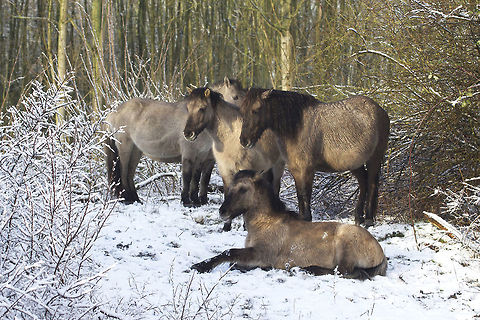
Naming
"E. ferus" had several subspecies. Three survived into modern times:⤷ The domestic horse.
⤷ The tarpan or Eurasian wild horse, once native to Europe and western Asia, became effectively extinct in the late 19th century, and the last specimen died in captivity in an estate in Poltava Governorate, Russian Empire, in 1909.
⤷ Przewalski's horse, also known as the Mongolian wild horse or Takhi, is native to Central Asia and the Gobi Desert.
The latter two are the only never-domesticated "wild" groups that survived into historic times. However, other subspecies of "Equus ferus" may have existed and could have been the stock from which domesticated horses are descended.At present, the domesticated and wild horses are considered a single species, with the valid scientific name for the horse species being "Equus ferus." The wild tarpan subspecies is "E. f. ferus", Przewalski's horse is "E. f. przewalskii", and the domesticated horse is "E. f. caballus". The rules for the scientific naming of animal species are determined in the International Code of Zoological Nomenclature, which stipulates that the oldest available valid scientific name is used to name the species. Previously, when taxonomists considered domesticated and wild horse two subspecies of the same species, the valid scientific name was "Equus caballus" Linnaeus 1758, with the subspecies labeled "E. c. caballus", "E. c. ferus" Boddaert, 1785 and "E. c. przewalskii" Poliakov, 1881. However, in 2003, the International Commission on Zoological Nomenclature decided that the scientific names of the wild species have priority over the scientific names of domesticated species, therefore mandating the use of "Equus ferus" for the horse, independent of the position of the domesticated horse.

Evolution
"E. ferus" had several subspecies. Three survived into modern times:⤷ The domestic horse.
⤷ The tarpan or Eurasian wild horse, once native to Europe and western Asia, became effectively extinct in the late 19th century, and the last specimen died in captivity in an estate in Poltava Governorate, Russian Empire, in 1909.
⤷ Przewalski's horse, also known as the Mongolian wild horse or Takhi, is native to Central Asia and the Gobi Desert.
The latter two are the only never-domesticated "wild" groups that survived into historic times. However, other subspecies of "Equus ferus" may have existed and could have been the stock from which domesticated horses are descended.The horse family Equidae and the genus "Equus" evolved in North America, before the species moved into the Eastern Hemisphere. Studies using ancient DNA, as well as DNA of recent individuals, shows the presence of two closely related horse species in North America, the wild horse and the "New World stilt-legged horse;" the latter is taxonomically assigned to various names.
Currently, three subspecies that lived during recorded human history are recognized. One subspecies is the widespread domestic horse, as well as two wild subspecies, the recently extinct tarpan and the endangered Przewalski's horse.
Genetically, the predomestication horse, "E. f. ferus", and domesticated horse, "E. f. caballus", form a single homogeneous group and are genetically indistinguishable from each other.
The genetic variation within this clade shows only a limited regional variation, with a notable exception of Przewalski's horse. Przewalski's horse has several unique genetic differences that distinguish it from the other subspecies, including 66 instead of 64 chromosomes,
unique Y-chromosome gene haplotypes,
and unique mtDNA haplotypes.
Besides genetic differences, osteological evidence from across the Eurasian wild horse range, based on cranial and metacarpal differences, indicates the presence of only two subspecies in postglacial times, the tarpan and Przewalski's horse.
References:
Some text fragments are auto parsed from Wikipedia.